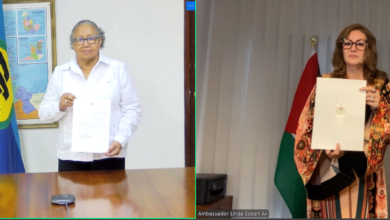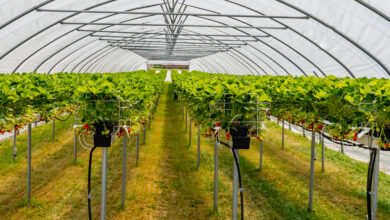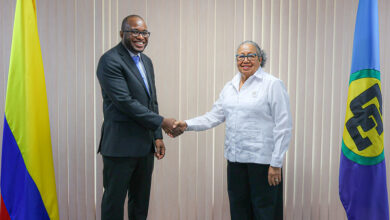I am very pleased to participate in the third meeting of the US-Caribbean Joint Committee on Department, Finance, and the Environment. Since the signing of the Bridgetown Accord just over two years ago, USAID has played a key role in assisting both the USG and the Caribbean governments pursue our joint commitments under the Accord. The extra ordinarily high degree of cooperation between U.S. government agencies, including USAID and the Department of State, and CARICOM , the Organisation of Eastrn Caribbean States and other regional bodies has been a foundation for the progress we have achieved.
It is in this spirit that we have gathered to review where we are and what more can be done to further the Action Plan that resulted from the agreements reached under the Bridgetown Accord. In undertaking such a review, I would like to note USAID’s major activities over the apst two years and the events, including two new major programmes, it proposes for the third year of the Action Plan.
While USAID has remained very active in the Eastern Caribbean, the closing of the regional office in 1996 resulted in the misperception that we were no longer assisting the region. The lack of a USAID physical presence perhaps has made it more difficult for our Caribbean partners to recognise the extent of our cooperation. Our commitment to sustainable development in the region, however, is unwavering. Since 1996, USAID has used different mechanisms to provide assistance to Eastern Caribbean institutions, such as the OECS, the University of the West Indies, and the Caribbean Development Bank. To support this wide array of projects, I am pleased to announce that USAID will assign a technical advisor to the Eastern Caribbean to reestablish a physical presence in the region.
If the per capita assistance figures mentioned by Ambassador Hamilton surprise you, I assure you that they are accurate. As specified in the Bridgetown Accord, we have maintained robust programmes in Haiti and the Dominican Republic and have safeguarded our programmes in Jamaica and Guyana. USAID provided a total of over $136 million to fund these four bilateral programmes for FY99 and provided another $86.5 million for hurricane relief and reconstruction assistance to the Caribbean.
In addition to our bilateral programmes, USAID’s intensive use of Caribbean regional programmes has contributed significantly to the success achieved over the last two years. During this time, USAID provided over $3.9 million to facilitate trade, $1.6 million to protect the environment, $4.3 million to mitigate disasters, $1.2 million for academic and technical training, $1 million to develop microenterprises, and $750,000 for smaller programmes, including community infrastructure development.
Although this regional assistance will be discussed more fully during Working Groups, I would like to highlight certain achievements in each of the sectors.
Facilitating Trade:
USAID’s assistance to facilitate trade is focused on helping the OECS States and other CARICOM members meet WTO standards and on preparing them to become members of the Free Trade Area of the Americas.
First, to help meet WTO agriculture standards, USAID has undertaken specific programmes to deepen understanding of sanitary and phyto sanitary requirements, to develop import/export protocols, to improve technical and analytical capacity in trade policy, and to design and implement food safety systems that meet international standards. We also helped establish data bases and internet systems to ensure dissemination of marketing information and regional trade policies.
Second, together, we have worked hard to develop a Trade Information Network, or “Virtual Secretariat”. This promising initiative supports CARICOM’s participation in hemispheric economic integration by establishing a trade information network linked by computer. The network will provide a forum for sharing information to advance trade negotiations and liberalisation trade policies. Seven sites have already been liked. These include the CARICOM Secretariat, the London based Chief Negotiator, the Regional Negotiating Machinery (RNM) in Barbados, the OECS Secretariat in St. Lucia, the Technical Unit for Trade Studies in Jamaica, the Eastern Caribbean Central Bank in St. Kitts and the RNM Washington office.
Third, USAID is also providing technical assistance to reform customs and commercial laws and to open the telecommunication market. Five advisors have been assigned to provide long-term technical assistance to the Caribbean Association of Industry and Commerce.
Protecting the Environment:
USAID’s assistance in the environment has been equally impressive. As the tourist industry grows throughout the Caribbean, the importance of protecting the environment cannot be underestimated. The Environmental and Coastal Resources Project (ENCORE) is just one of several regional programmes managed by the USAID Mission in Jamaica. ENCORE is aimed specifically at protecting the Eastern Caribbean’s natural resource base and biodiversity by promoting collaboration between public, private and community interests pursuing economic development. The Soufriere Marine Management Area in St. Lucia is an excellent example of this type of collaboration.
The Sustainable Tourism initiative was launched just last year. This programme will assist the development of a regional policy for sustainable tourism with a plan of action to achieve benchmarks in areas such as waste management and energy conservation.
The USAID Mission in Jamaica also manages the Caribbean Environmental Network Project, which has been instrumental in developing environmental education programmes that raise public awareness and integrate environmental considerations in other sectors.
Disaster Mitigation:
USAID has been instrumental in developing disaster mitigation expertise throughout the entire Caribbean .In addition to funding provided by USAID for hurricane reconstruction in the Eastern Caribbean and the Dominican Republic, the Office of Foreign Disaster Assistance (OFDA) provided over $4.3 million for disaster planning, mitigation, and response over the past two years. OFDA’s programme and our response to Hurricane Georges are a clear indication of USAID’s commitment to ensuring development gains in the Caribbean are not washed away.
Some of the smaller activities we are funding also have benefited many people and their families throughout the Region.
Windward Islands Diversification Project:
Under the Windward Islands Diversification Project, the university of the West Indies provided short-term technical training to 1,127 persons, and eight students, two from each of the Windwards are now attending post-graduate level programmes in the United States.
This Project also funded 25 community infrastructure projects, including water supply systems, health facilities, and village roads. USAID provided $1 million to the Caribbean Development Bank for equipment and on-lending for microenterprises, and established a loan guarantee programme that enables the Royal Bank of Trinidad to make $3 million in new loans. USAID also placed four advisors with the National Development Foudnations in the Windward Islands and one with the Confederation for Credit unions in Barbados to provide long-term technical assistance.
Two key activities yet to take place over the next few months include:
- The broadening of the CARICOM Trade information Network by linking the Ministries responsible for trade matters in each of the 14 English speaking CARICOM member countries; and
- The development of a comprehensive system to certify crops that have been organically grown. This certification system supports the entry of bananas and other crops in the “high end” market for organically grown crops that may sell for prices up to 40% higher than regular market prices.
I would like to close by outlining three major events USAID is planning this year to promote Caribbean competitiveness and two new development programmes spanning the next five years:
First – We propose to host a conference in September for trade and agriculture ministry officials with the aim of raising awareness of agricultural and trade policies and increasing the understanding of data and analysis used to comply with FTAA and WTO standards. This conference will provide a valuable opportunity for CARICOM participants to interact with USG officials and organisations that support the FTAA accession process.
Second – We anticipate holding a workshop that will address the interpretation and practical applications of economic analysis to agricultural policies, including protectionism and competitiveness.
Third – We propose to hold a series of workshops on increasing production and consumption of Caribbean agricultural products.
USAID’s two new development programmes spanning the next five years include:
- A five-year $30 million regional strategy has been developed to cover the Caribbean with special emphasis on the Windwards, which we will discuss later this morning; and
- A three-year disaster mitigation programme now being developed by USAID’s Office of Foreign Disaster Assistance. This programme is still in the design stage but it builds on OFDA’s long record of successful programmes in disaster mitigation.
The Bridgetown Accord demonstrates the special status the United States government gives the Eastern Caribbean as part of its commitment to Small Island Developing States and its support for the UN 5-YEAR Review of the Barbados Plan of Action. USAID’s partnership with organisations such as CARICOM, the OECS, the University of the West Indies and the Caribbean Development Bank remains our best avenue to address the region’s development challenges. We look forward to discussing how to ensure we continue making progress towards the sustainable development objectives we have set.
Thank you.





